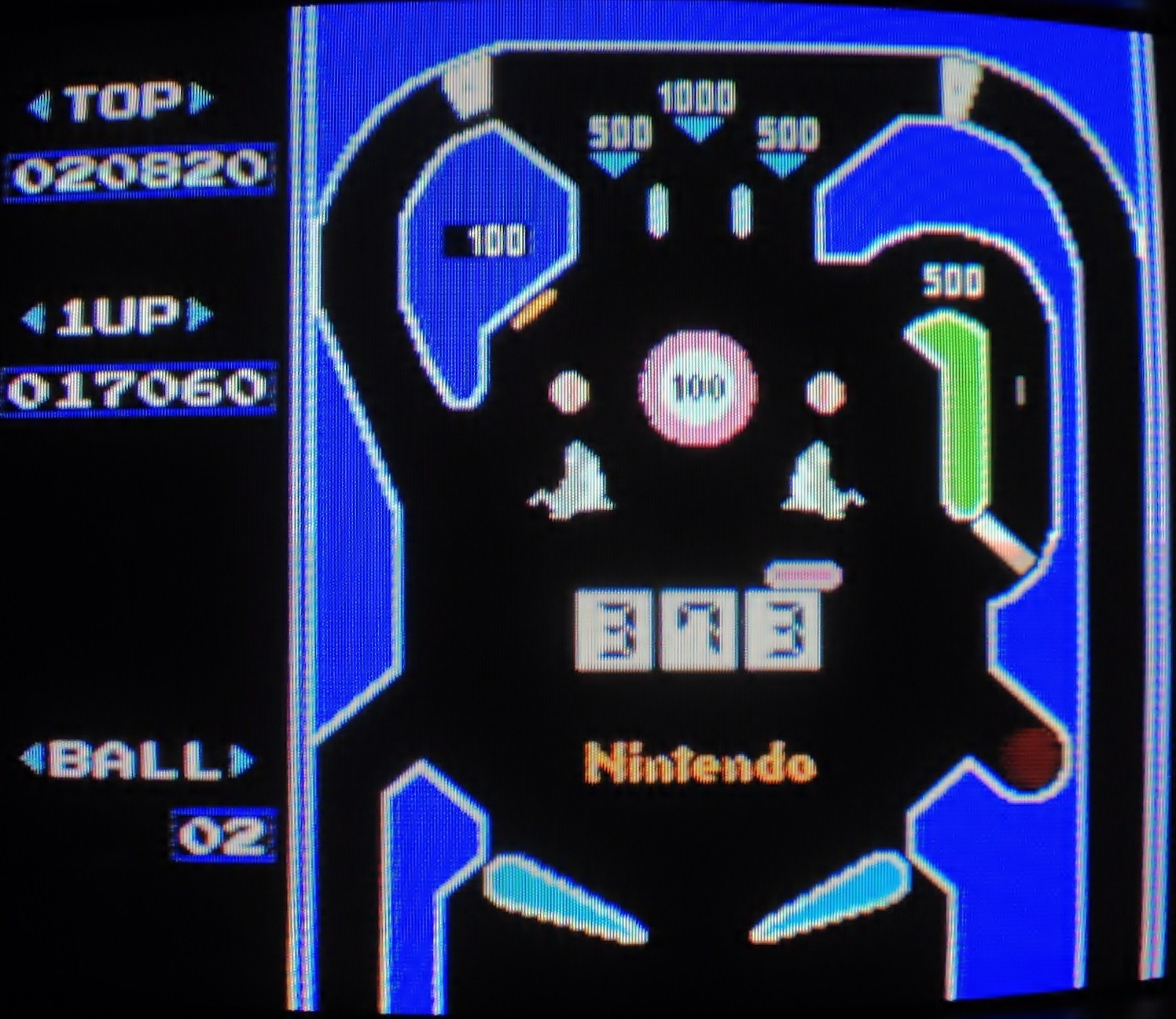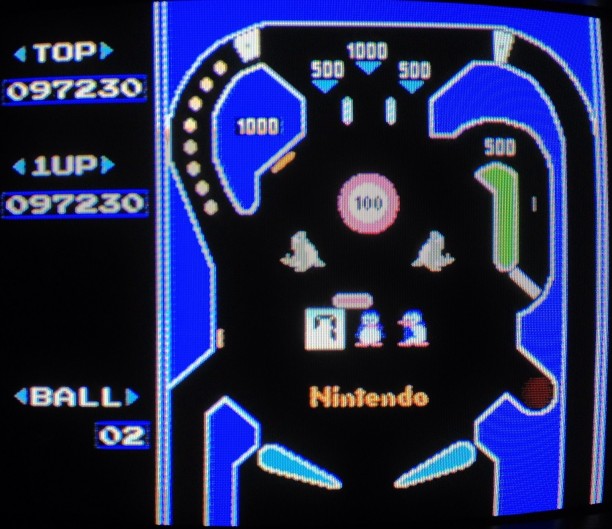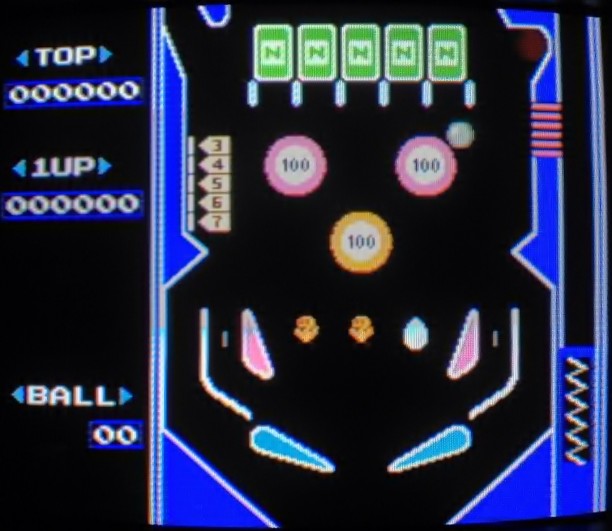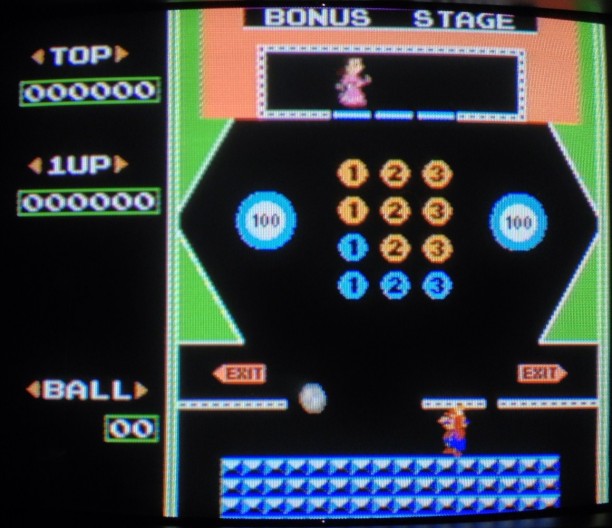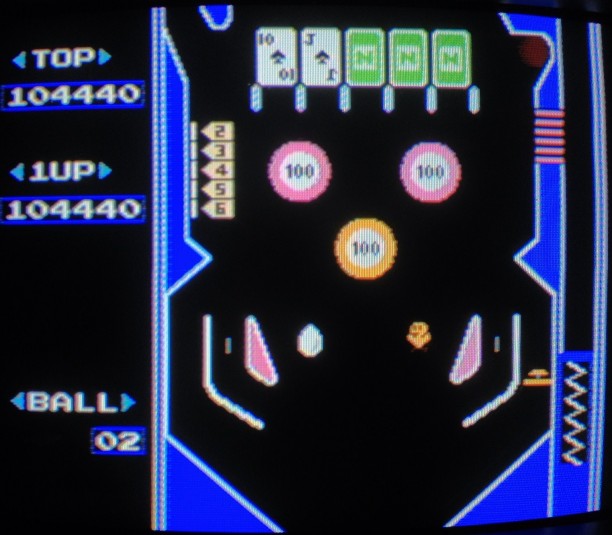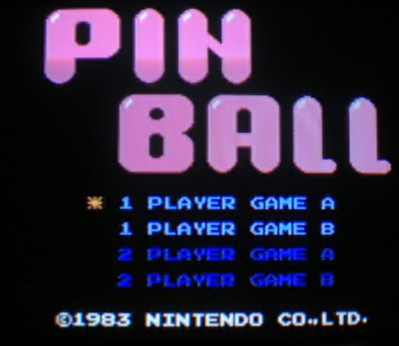
Pinball Alley
Pinball (NES)
It’s kind of a no-brainer to kick off Pinball Alley by talking about, well… Pinball. Sure, there are other pinball games for the Nintendo Entertainment System that are better, more complex, or even recreations of actual licensed pinball tables; however, Pinball from Nintendo is really where my story begins.
Pinball, as a game, is a solid mix of skill and luck. The skill required to achieve high scores includes being able to time flipper shots to accurately hit targets, ramps, rollovers, and other spots on the playfield. Players must have the ability to concentrate and follow the silver ball as it careens to and fro from bumper to bumper. Strong players must be able to understand the basic objectives for each table played; some may revolve around repeat ramp shots to achieve multiball, while others may want players to hit certain rollovers or targets for maximum bonuses. Mastering a physical pinball machine also requires knowing when and how much to nudge the machine, which can be the difference between watching a ball drain to the outhole or saving it and keeping a run going.
Pinball games are my favorite kind of games to play. As an arcade rat from the 1980s, I grew up around pinball machines. I used to play for as long as my allowance would hold out. Then I would watch others– usually adults– play the same tables and try to gain understanding of objectives and goals so that my future scores would be better. Sometimes I would even score a few credits from someone who had to leave in a hurry, and I would practice what I saw. Unfortunately, malls close and people go home… so home pinball games are where I got to hone my skills and technique.
Pinball was the first game for the NES that I played that tried to emulate the pinball experience. While it’s missing quite a few bells and whistles that authentic pinball machines have, Pinball does manage to bring some of the core ideas and competencies that makes playing these games so addictive and satisfying. There are drop targets to take down, rollover shots to hit, capture holes to target, and high scores to conquer. It’s a game that still holds up well for occasional play, and it has a couple of surprises that other pinball games don’t have.
Pinball takes place on a split playfield, top and bottom. The manual refers to these areas as “scenes”, but that really isn’t the best term to use. The “Top” playfield has several points of interest. The first is a progressive target that starts at 100 points and increases by 100 points with each successive hit up to a maximum of 1000 points for each hit registered. Just to the left of that is a rollover that, when the ball goes through it, earns the player 2000 points and a fun display with the seals in the center of the playfield. There’s one drawback with hitting this rollover, however; the progressive target drops back to the original value of 100 points. For those skilled enough to increase the progressive target to the max, hitting the rollover is almost like getting penalized. This is a theme that we’ll revisit later when talking about the “Bottom” playfield.
Another notable feature of this “Top” playfield is the slot machine feature. Three windows, each containing a penguin, the number 3, and the number 7, activate when players hit the 500-point rollover on the right-hand side of the playfield. A moving target glides from left to right and back just above these windows. In order to stop each window, the target must be struck as it’s positioned over the top. The window will stop and display a value, and the objective is to get three of a kind. Three 3s earn a 3,330 point bonus, while three 7s earn 7,770 points, and both of these raise a peg between the flippers that helps to keep the ball in the playfield. Getting three penguins in a row also raises the peg, plus it initiates a brief period of double scoring for all shots. Getting the 7s is the best outcome for scoring in most instances, but it’s a real challenge to get three of a kind at all. I’ve been unable to do it in all of my years of play.
If the ball escapes down the left outlane or down the center of the playfield between the flippers, the “Bottom” playfield becomes active. This is the more daunting of the two fields for several reasons:
- The trio of bumpers in the center, which I call the “Bumper Triangle”, makes it difficult to aim shots and can send the ball hurtling in haphazard directions.
- Losing the ball down either the left or right side outlanes or down the center ends the player’s turn, so there’s more pressure to be cautious or nervous.
- The side bumpers can occasionally send balls right to the outlanes.
As with the “Top” playfield, there are two main areas of interest here. The first is the bank of drop targets on the left-hand side of the screen. Dropping all of these targets opens a passageway to the plunger/ball launch area, which can be used to get the ball back to the safer “Top” level. Dropping these targets is fairly simple, but there are challenges afterwards. Getting the ball into that passageway requires a very accurate shot; also, if the ball passes through either of the inside outlanes, the targets reset and the passageway becomes shut once again. It may be simpler to use what’s called a “back door” shot to drive the ball back up the lane in the upper left-hand corner of the playfield. As we saw in the upper level with the rollover that reset the progressive target, there’s a sense of reversed accomplishment with one unlucky or unwise shot when it comes to the drop targets and outlanes here. This is an unusual penalizing aspect of pinball game mechanics. A couple of Zen Studios‘ pinball tables also have penalizing mechanics, such as Ghost Rider or Boba Fett, but this is not the norm. It does make for more strategy in shot selection, and adds a bit of unexpected tension.
The other notable point is the capture hole, located in the upper right-hand corner of the table. Executing this shot is extremely difficult, thanks to the “Bumper Triangle” and where the hole is placed. Once it drops, though, a third area of the game is opened up that showcases Mario and a fair damsel in distress.
This Bonus Stage is a significant departure from the standard pinball experience offered. Here, players control Mario with a girder overhead by moving him left and right with the D-pad. The objective here is to spot all of the lamps in at least one column of numbers as the same color. Doing so will break away a part of the floor that the damsel is walking on, and she will be freed from her prison. Mario’s job is not over at this point, though. Mario must then position himself underneath the descending damsel so that she can land safely and be guided to either exit. Failure to do so ends the player’s turn, plus Mario will endure much shame and sadness. Success, on the other hand, earns the player a bonus of 10,000 points. That’s the biggest bonus in the game.
This Bonus Stage is not easy at all. Much like my track record with the slot machine windows on the “Top” playfield, I’ve had no success freeing the damsel and collecting the reward. It’s tough to get the colors of the lamps to light up, and ball control with Mario and the left-to-right movement is much more limited than with flippers. The huge bonus is a nice perk, but my experience inevitably leads to the ball draining down one of the side and being kicked back into play on the “Top” playfield. I do like the idea of a Bonus Stage, but the idea was built upon and improved in many later pinball games, such as Alien Crush, High Speed, and several of Zen Studios‘ modern-day efforts.
There are a couple of other notable events that occur in Pinball, based on scoring. At 50,000 points, players are awarded with an extra ball. At 100,000 points, though, the game throws an unexpected challenge at you as the flippers disappear. The first time this happened to me, I was not ready. I paused the game and literally stared at TV screen with my jaw wide open. It’s a nasty surprise because getting to 100,000 points is a moderate accomplishment. It feels like a great run as the score rolls towards six figures, then it suddenly becomes nearly impossible to line up flipper shots because the outline of the flippers is missing. If players can survive until reaching 150,000 points, the flippers do return and normalcy is restored.
Ultimately, Pinball still holds up today, but in limited doses. It doesn’t have the bells and whistles that some NES pinball games have, nor does it have the variety of modes that others have. There’s almost no music to speak of, and the sound effects get obnoxious. Despite all of these omissions and limitations, there is still a very playable core experience to be had. The ball physics are fair, basic pinball competencies such as key flipper shots and elimination of drop targets are included, and it can be fun setting high scores to go back and try to best the next time. This isn’t the first pinball game that I reach for when I feel like testing my skills, but I can confidently say that it’s not the worst, either.
For those of you who have Pinball, I’d love to read your own stories and high score accomplishments. Feel free to drop them in the comments below.
